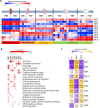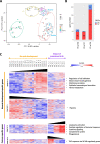Time-resolved transcriptomic profiling of the developing rabbit's lungs: impact of premature birth and implications for modelling bronchopulmonary dysplasia
- PMID: 36922832
- PMCID: PMC10015812
- DOI: 10.1186/s12931-023-02380-y
Time-resolved transcriptomic profiling of the developing rabbit's lungs: impact of premature birth and implications for modelling bronchopulmonary dysplasia
Abstract
Background: Premature birth, perinatal inflammation, and life-saving therapies such as postnatal oxygen and mechanical ventilation are strongly associated with the development of bronchopulmonary dysplasia (BPD); these risk factors, alone or combined, cause lung inflammation and alter programmed molecular patterns of normal lung development. The current knowledge on the molecular regulation of lung development mainly derives from mechanistic studies conducted in newborn rodents exposed to postnatal hyperoxia, which have been proven useful but have some limitations.
Methods: Here, we used the rabbit model of BPD as a cost-effective alternative model that mirrors human lung development and, in addition, enables investigating the impact of premature birth per se on the pathophysiology of BPD without further perinatal insults (e.g., hyperoxia, LPS-induced inflammation). First, we characterized the rabbit's normal lung development along the distinct stages (i.e., pseudoglandular, canalicular, saccular, and alveolar phases) using histological, transcriptomic and proteomic analyses. Then, the impact of premature birth was investigated, comparing the sequential transcriptomic profiles of preterm rabbits obtained at different time intervals during their first week of postnatal life with those from age-matched term pups.
Results: Histological findings showed stage-specific morphological features of the developing rabbit's lung and validated the selected time intervals for the transcriptomic profiling. Cell cycle and embryo development, oxidative phosphorylation, and WNT signaling, among others, showed high gene expression in the pseudoglandular phase. Autophagy, epithelial morphogenesis, response to transforming growth factor β, angiogenesis, epithelium/endothelial cells development, and epithelium/endothelial cells migration pathways appeared upregulated from the 28th day of gestation (early saccular phase), which represents the starting point of the premature rabbit model. Premature birth caused a significant dysregulation of the inflammatory response. TNF-responsive, NF-κB regulated genes were significantly upregulated at premature delivery and triggered downstream inflammatory pathways such as leukocyte activation and cytokine signaling, which persisted upregulated during the first week of life. Preterm birth also dysregulated relevant pathways for normal lung development, such as blood vessel morphogenesis and epithelial-mesenchymal transition.
Conclusion: These findings establish the 28-day gestation premature rabbit as a suitable model for mechanistic and pharmacological studies in the context of BPD.
Keywords: Bronchopulmonary dysplasia; Lung development; Premature birth; Proteomics; Transcriptomics.
© 2023. The Author(s).
Conflict of interest statement
MS, MLF, CC, GV, BP, FS and FRC are employees of Chiesi Farmaceutici S.p.A.; XM served as a consultant for this study.
Figures







References
-
- Bancalari E. Molecular bases for lung development, injury, and repair. In: Polin RA, editor. Newborn lung neonatol quest controv. Saunders; 2012. pp. 3–27.
MeSH terms
LinkOut - more resources
Full Text Sources
Molecular Biology Databases

